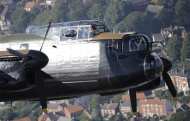I was a boy once. When I was 8 in 1962, the war was still vivid in the dreams of my parents. My mother's father lost an eye to a glass splinter when his home was bombed but their immediate families survived. In 1962, we played at being fighter planes: running around the field with our arms outstretched making neeeooooowww and budda-budda-budda sounds. All good fun, good exercise and nobody died. 20 years earlier lots of young people were dying, especially aircrew and especially those in British Bomber Command. The only military cohort of the 20th century with higher mortality were front-line infantry in some sections of the WWI trenches. In rough terms half of bomber crews failed to survive the war. My mother was 19 when WWII broke out. In the early part of the war she was serving in the ATS at various locations across the South of England. She dated a couple of really nice boys from nearby RAF bases until they failed to return; I guess it made everyone a bit wary of commitment.
The Air Ministry maintained an Operational Research Section ORS which gave office-space for boffins to analyse data and inform policy. 19 y.o. mathematical physicist Freeman Dyson started working there in 1943 and crunched all the data to which he could get access. Remember Abraham Wald using science and insight to decide where planes needed armour? The problem for the ORS was that the hierarchy of Bomber Command refused to listen to much of the evidence presented by their ORS unless it was consonant with what "Bomber" Harris and his cabinet of death already knew to be true.
For example, Dyson calculated the rate of survival of bomber-crews obliged to exit the bus because it had been fatally damaged by enemy action. British aircrew had a 12% successful bale-out rate compared to 50% survival among their opposite numbers in the USAAF. The rate was worst in Lancaster bombers and Dyson and his OSR room-mate Michael O'Loughlin were convinced that the small size of the Lancaster's escape hatches was the primary reason for the excess mortality. These doorways to salvation were 560mm x 670mm in size and you are urged to draw a rectangle that size on the kitchen table and imagine pitching through it, at night, at 500km/hr, wearing a padded flight-jacket and a parachute. The equivalent exit on the Halifax was 50mm wider and the rate of survival was thereby doubled.
Yet the Lancaster [R] was deemed to be the most successful of the British bombers by defining success as "delivering 608,612 long tons of bombs in 156,000 sorties" rather than as % disruption of German rail-traffic or ball-bearing factories destroyed. Dyson estimates that the amount of damage to the German economy was about half the cost of having built the bombers which were destroyed in the process. More than 7,000 Lancasters were built at a cost in 1940-£s of £50,000; just under half of which were destroyed and only 35 [0.5%] succeeded in carrying out 100 missions. Ryanair would go out of business with that sort of failure rate. And for what? Mike Bayon reports that 3% of the payload of British Bomber Command was "on target" as defined as "within 5 miles".
The rates of return after a mission were so appalling that everyone, including the flight-crews, noticed. Bomber command put it about that the crews that died (tsk tsk most unfortunate very sorry) were the absolute beginners. As you gained experience, albeit by being tempered in a furnace, you were less likely to die. But Dyson crunched the data and showed that it was just a lottery. You were as likely to go west on your 30th mission as on your 3rd. That message was going to be extremely bad for morale and so it was suppressed. Dyson & Co. took this information [that something unknown was killing even experienced crews] and reports from rear-gunners to conclude the two rear gun-turrets were useless as defensive weapons AND added an enormous aerodynamic drag. Stripping out the gun-turrets would a) reduce the crew from 7 to 5 and reduce deaths by 30% b) allow the planes to travel 80km/h faster and consequently go there and back, and be over the target getting shot at, for a shorter time. This evidence-driven suggestion was also ignored. The rear-gunner courageously covering his pals was too propaganda too powerful to edit out.
In a similar matter, Dyson carried out some statistical and theoretical studies to determine the likelihood of two bombers colliding while over Germany compared to their chance of being shot down by enemy fighters. With little data and big errors he was able to show that you had to worry a lot more about the fighters than the collisions and so pilots were safer travelling closely together like convoys of ships were concurrently being protected from u-boat attack. The theoretical answer was sufficiently close to the statistical answer to give mutual credence to the two quite independent calculations.
I don't think that Dyson has ever come to terms with the fact that he was unable to present information and data-analysis in such a way that it would make a difference to the chaps his age who were being shot down in flames several nights a week over Germany.

No comments:
Post a Comment